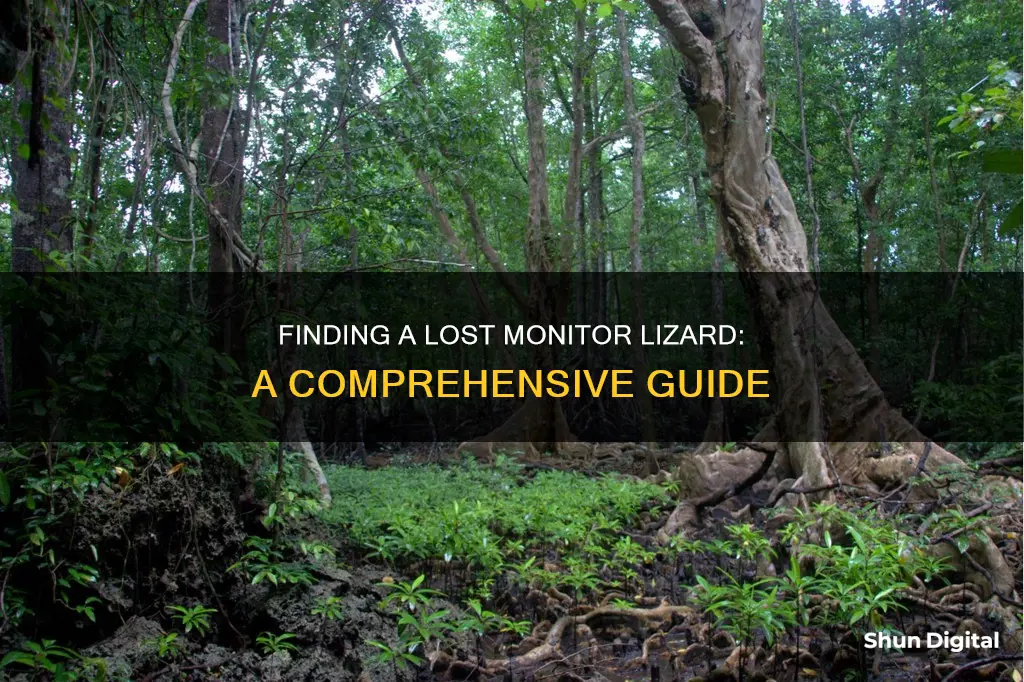
Monitor lizards are native to Africa, Asia, and Oceania, with one species found in the Americas as an invasive species. They are not native to Arizona, but are sometimes kept as exotic pets. They can grow to be over 3 metres long, and are known for their long necks, powerful tails and claws, and well-developed limbs. They can be hard to find if they go missing, as they can fit into small spaces. If you've lost a monitor lizard, you should search your entire home, paying special attention to small spaces and warm spots. You can also set up warming and feeding stations to attract your pet.
| Characteristics | Values |
|---|---|
| Search area | Entire home, including small spaces and nooks and crannies |
| Specific places to look | Under dressers, bookcases, closets, baseboard heating panels, radiators, forced hot air registers, behind refrigerator and other warmth-emitting appliances |
| Ways to attract the lizard | Set up warming and feeding stations with lamps, flour, water |
| Keep the lizard's cage open |
What You'll Learn

Search your home thoroughly, looking in small spaces
Monitor lizards can fit into extremely small spaces, so it's important to search your home thoroughly, paying extra attention to small areas. Look beneath and behind furniture, appliances, and heavy items, such as dressers, bookcases, and the refrigerator. Monitor lizards are also attracted to warmth, so check any warm spots in your home, including baseboard heating panels, radiators, and forced hot air registers. Use a flashlight (and a small mirror, if necessary) to inspect these tight spaces before attempting to move anything, as you may accidentally injure your lizard. If you need to move something, do it very slowly so that the lizard has time to move out of the way.
In addition to checking small spaces, don't forget to look in dark places, closets, and under beds and bulky furniture. Shaking a food dish or a favourite toy may also help lure your lizard out of hiding. If you have a basement or an attic, be sure to search these areas as well. Check inside drains and sheds, and look under porches, parked cars, and shrubs. It's a good idea to search your home multiple times, as your lizard may move to different locations within your house.
If you suspect that your lizard may have escaped outside, search your yard and the surrounding area. Check backyards with the owners' permission, as well as green spaces and other nearby spots. Look under porches and shrubs, and ask your neighbours to check their sheds and garages in case your lizard accidentally got locked in.
Monitoring Your Child's iPhone: A Parent's Guide
You may want to see also

Set up warming and feeding stations
Once you've determined that your monitor lizard is lost, the next step is to set up warming and feeding stations throughout your house. These stations will attract your pet lizard and provide warmth to buy you more time to find it.
Firstly, gather several clip-on lamps or desk lamps and place them on the floor in a central location in each room. Position the lamps close to the floor and adjust them to emit warmth. Place a small saucer of water near each lamp.
If you have carpeted floors, put down some newspaper and sprinkle flour on top. This will help you identify if your monitor lizard has been in the area. Close all interior doors and, if there is a gap underneath, roll up a towel to block the space. This will help contain your pet in one room.
Monitor the stations every few hours and examine the floured area for footprints. If you've determined that your monitor lizard is in a specific room, place a few additional warming lamps and water stations inside. Keep the room off-limits to children and other pets.
Monitor lizards are skilled predators and scavengers. Their diet includes insects, birds, rodents, fish, frogs, other reptiles, eggs, and carrion. They are true opportunists, eating almost anything small enough to catch.
When feeding your monitor lizard, it's important to know its natural diet. Some monitors, like the savannah monitor, are strict insectivores in the wild and should primarily be fed insects. Avoid live feeding mammals and birds, as these animals can seriously injure your monitor when being hunted.
- Crickets
- Mealworms
- Waxworms
- Roaches
- Locusts
- Phoenix worms
- Horn worms
- Silkworms
- Whole fish (frozen-thawed)
- Salmon
- Sea bass
- Blue gill
- Tilapia
- Cod
- Grouper
- Catfish
- Snapper
- Sunfish
- Perch
- Other freshwater fish
- Vegetables (as a source of beta-carotene)
Adjusting Volume on Your ASUS 144Hz Monitor: A Simple Guide
You may want to see also

Check your pet's cage periodically
Monitor lizards are fast and can hide anywhere inside your house. They can fit into extremely small spaces, so you need to thoroughly search your home, looking into every nook and cranny. Pay special attention to small areas beneath furniture and inside closets.
Monitor lizards are also attracted to warmth. Baseboard heating panels, radiators, and forced hot air registers are common hiding spots. Use a flashlight and a small mirror to check these areas. If you need to move any appliances, do so very slowly, so that your lizard has time to move out of the way.
Testing Black Levels on an LCD Monitor: A Step-by-Step Guide
You may want to see also

Look out for references to sightings
Monitor lizards can be very good at hiding, so it is important to observe carefully and use your senses to find them. Knowing your lizard will make it much easier for you to find it. If your lizard is small, it will be harder to find than a larger one as it can fit into any holes.
- Listen out for any sounds. If your lizard is a geckos family, you can follow their sound as they usually produce sound to communicate or if they feel scared.
- Follow their droppings. This is an easy way to find your lizard. Simply follow the droppings to where they lead you.
- Move your furniture to have a clear view of the room. Move couches and other furniture up to the wall so you can clear each area and check for possible hiding places. Always check under the furniture as lizards like to hide there.
- Start with one room at a time. Close all the windows, doors, and any exits that they can fit through, such as cracks, exhaust pipes, etc. Then check all the possible open places they can hide, and also each piece of furniture in that room. Then move to another room and repeat the process.
- Bring your lizard out by placing a large amount of food that they can easily sense in one place. Lizards love to eat insects, fruits, or vegetables, so they will likely come out to get food.
- Turn the lights off as lizards like to go out in the dark.
- Moisturise the area as lizards need water to survive. They can also usually be found in bathrooms, so check that all the cupboards and drawers are shut and wait until they come out to get some water.
- Put some heat lamps out as small to medium-sized lizards love heat. Clip on heat lamps to your furniture and check on them in a few hours or minutes and you may see your lizard loving to bathe in the warmth.
Best Indoor Allergy Monitors: Breathe Easy at Home
You may want to see also

Use an ADOT camera to spot your lizard
If you've lost your monitor lizard, an ADOT camera can be a very useful tool to help you spot it. ADOT (the Arizona Department of Transportation) has a network of more than 400 cameras statewide, with the majority being along the major freeways in Phoenix and Tucson. These cameras are typically used to help manage traffic and provide real-time updates on weather conditions. However, they can also be used to spot your lost lizard. Here's how you can use an ADOT camera to your advantage:
Firstly, familiarize yourself with the ADOT camera system. Visit the ADOT website (az511.gov) or download the AZ 511 app on your mobile device. On the website, click on "Cameras" in the upper right corner to access the map with all the camera locations. On the app, choose "Road Cameras" after clicking on the three gold triangle icons in the lower right corner.
Once you have accessed the camera system, look for cameras in the specific area where you believe your lizard may be located. Keep in mind that most of the cameras are placed along major freeways, so focus your search on those areas. You can also set up personalized routes or select specific cameras that matter for your daily commute.
When you have identified the relevant cameras, start monitoring them regularly. Pay close attention to the images and look for any signs of your lizard. Monitor lizards can be quite large, with some species reaching over 3 meters in length, so they may be easier to spot compared to smaller lizards. Look for their distinctive long necks, powerful tails, and well-developed limbs.
Additionally, consider the habitat and behavior of monitor lizards. They are mostly terrestrial but can also be found in arboreal or semiaquatic environments. Monitor lizards are active hunters and often maintain large territories. Try to anticipate areas where your lizard may be likely to move or hunt.
If you spot your lizard on one of the ADOT cameras, act quickly. Contact the ADOT Traffic Operations Center and provide them with the camera location and a description of the situation. They can then dispatch the appropriate personnel to assist you in safely retrieving your lizard.
Remember, the key to using ADOT cameras effectively is to be proactive and vigilant. Monitor the cameras regularly, know the habits of monitor lizards, and don't hesitate to reach out for help if you spot your lizard. With persistence and a bit of luck, you'll be able to find your lost pet.
Bigger Monitors: Better Experience or Just a Myth?
You may want to see also
Frequently asked questions
First, perform a thorough search of your entire home, looking in every nook and cranny. Pay special attention to small areas beneath furniture and in closets. If that doesn't work, set up warming and feeding stations throughout your house. Place a lamp on the floor in a central location in each room, with a small saucer of water nearby. Sprinkle flour on the floor around the lamp to check for footprints.
Keep your lost pet's cage open and check it periodically—it's not unheard of for your pet to find its way back to its terrarium.
If your monitor lizard is in a hard-to-reach place, use a flashlight (and if necessary, a small mirror) to check the area before attempting to move objects. If you do need to move things, do it very slowly so the animal can move out of the way.







